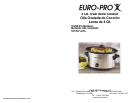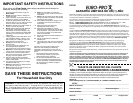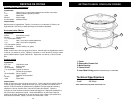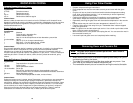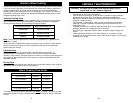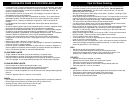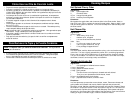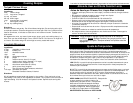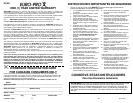
Tips for Slow Cooking
• The cover of the slow cooker does not form a tight fit on the ceramic pot but
should be centered on the ceramic pot for best results. Do not remove the
glass cover unnecessarily - this will result in major heat loss. Do not cook
without the glass cover in place.
• Stirring is not necessary when using a slow cooker. However, if cooking on high,
you may want to stir occasionally.
• Slow cooking retains most of the moisture in foods. If a recipe results in too much
liquid at the end of the cooking time, remove glass cover, turn the control knob to
high, and reduce the liquid by simmering. This will take 30-45 minutes.
• The slow cooker should be at least half-filled for best results.
• If cooking soups or stews, leave a 2-inch space between the top of the ceramic
pot and the food so that the recipe can come to a simmer.
• Many recipes call for cooking all day. You can also prepare the recipe the night
before by placing all ingredients in the ceramic pot, cover and refrigerate
overnight. In the morning, simply place the ceramic pot in the slow cooker and
select the temperature setting.
• Meat & Poultry require at least 7 to 8 hours on LOW. Do not use frozen meat in
the slow cooker. Thaw any meat or poultry before slow cooking.
• Trim all visible fat from meat or poultry.
• Cook dried beans 1-2 hours on high setting, then add the remaining ingredients,
cook on low for the remaining time.
• When cooking curries and casseroles, richer, more intensive flavors will develop
when the first stage is prepared by traditional methods, i.e. brown the onions,
meat and spices first in a non-stick pan.
DO’s
• Handle the ceramic pot and glass lid with care.
• Use oven mitts when lifting the ceramic pot containing hot foods.
• Avoid extreme temperature changes in the ceramic pot or glass lid. For
example, do not place into or under cold water while still hot.
DO NOT’s
• Use the ceramic pot if chipped or cracked.
• Operate the slow cooker without the ceramic pot in place.
• Place the hot ceramic pot onto a wet surface.
• Use frozen meats or foods in slow cooker. Always defrost them first.
• Place the glass lid in oven or microwave.
NEVER
• Use abrasive cleansers or metal scouring pads when cleaning the ceramic pot.
• Place water or other liquids into the base of the slow cooker.
• Immerse the base, cord or plug of the slow cooker into water.
• Touch hot surfaces with bare hands.
6
CONSEJOS PARA LA COCCIÓN LENTA
• La tapa de la olla no cierra herméticamente contra la fuente de cerámica, pero debe
colocarse lo mejor posible para obtener los mejores resultados. No levante la tapa
de vidrio innecesariamente – producirá una pérdida considerable de calor. No
cocine sin la tapa colocada.
• No es necesario revolver al cocinar lento. Sin embargo, al cocinar en HIGH, es
aconsejable revolver ocasionalmente.
• La cocción lenta retiene casi toda la humedad de la comida. Si su receta resulta
demasiado líquida al final del tiempo de cocción, quite la tapa de vidrio, ajuste la
temperatura a HI, y reduzca el líquido por evaporación. Esto le llevará 30-45
minutos.
• La olla debe estar llena hasta la mitad como mínimo para obtener los mejores
resultados.
• Al cocinar sopas o guisos, deje unas 2 pulgadas entre la comida y la parte de arriba
de la fuente de cerámica para permitir que la comida hierva lentamente.
• Muchas de las recetas necesitan todo un día de cocción. También puede preparar
la receta la noche anterior poniendo todos los ingredientes en la fuente de
cerámica, tapándola y guardándola en la heladera durante la noche. En la mañana,
coloque la fuente de cerámica en la olla y elija la temperatura deseada.
• La carne y las aves requieren por lo menos 7-8 horas en LOW. No use carne
congelada en la olla de cocción lenta. Descongele la carne o las aves antes de
cocinarlas.
• Saque toda la grasa visible de la carne o las aves.
• Cocine frijoles secos 1-2 horas en High, luego agregue el resto de los ingredientes y
cocine en Low por el tiempo restante.
• Al cocinar guisos y estofados, obtendrá un sabor más rico e intenso si prepara los
primeros pasos con métodos convencionales, por ejemplo dorando las cebollas, la
carne y condimentos primero en una sartén antiadherente.
LO QUE DEBE HACER
• Tenga cuidado al manipular la fuente de cerámica y la tapa de vidrio.
• Use agarraderas al levantar la fuente de cerámica con comida caliente.
• Evite los cambios extremos de temperatura en la fuente de cerámica y la tapa de
vidrio. Por ejemplo, no los coloque debajo de agua fría mientras estén calientes.
LO QUE NO DEBE HACER
• Usar la fuente de cerámica cuando esté rajada o rota.
• Usar la olla de cocción lenta sin la fuente de cerámica colocada.
• Colocar la fuente de cerámica sobre una superficie húmeda.
• Usar carne o comida congelada en la olla de cocción lenta. Siempre descongelarlos
primero.
• Colocar la tapa de vidrio en el horno o el microondas.
NUNCA
• Usar limpiadores abrasivos o esponjas de metal para limpiar la fuente de cerámica.
• Colocar agua u otros líquidos en la base de la olla de cocción lenta.
• Sumergir la base, cable o enchufe de la olla en agua.
• Tocar las superficies calientes con las manos.
17



